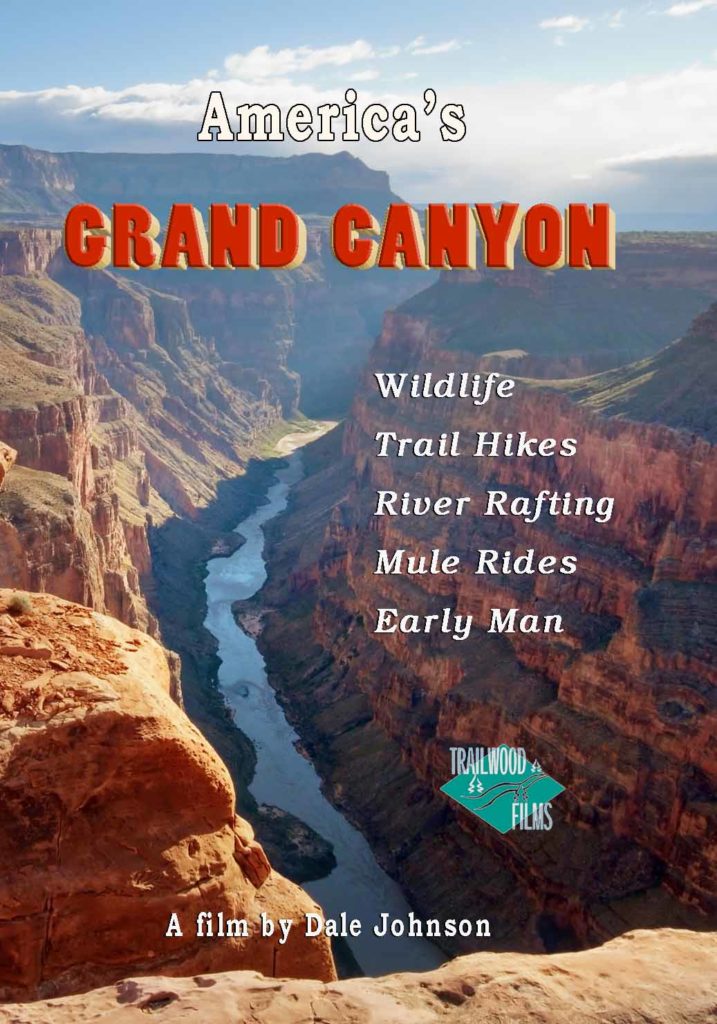"America’s Grand Canyon"
Out of the somber gray limbo that fills the screen, a mountain appears near the bottom through the mists. Anywhere else in the world this would be considered a mountain, but here, it is only a small peak in The Canyon
 $9.95
$9.95
Using B&W stills, Major Powell’s 1869 expedition down the Colorado River and it’s historical significance will be highlighted. Continuing to use B&W, we take a look at the Kolb brothers who explored and publicized the Canyon extensively during the early part of the 20th Century. They were instrumental in the creation of Grand Canyon National Park because of the public awareness generated by their writings and pictures.
The arrival of spring has sent flowers pulsing into full bloom. Mule deer browse in the forests on the rims of the Canyon and fawns cavort with each other and nurse their mothers. On the North Rim the Kaibab squirrel, rarest squirrel in North America, displays his white tail, searches for pine cones.
On the edge of the Canyon cicadas buzz in the morning air and canyon lizards pick up ants. Suddenly the lizard lunges for the cicada. The cicada makes a narrow escape, only to be plucked up and eaten by a huge raven who has just landed under the tree. The raven pauses on the lip of the Canyon, then launches himself out over the abyss. From the raven’s point of view, we soar over the various formations within the Canyon
Now clouds begin to coalesce in the sky; building; growing. The sky darkens, lightening flashes and crashes. A chipmunk darts into a hollow log. A horned lizard scurries to avoid the downpour. In the distant desert it’s not even raining, but a wall of muddy water rushes down a dry riverbed. Flashflood!
Nightfall and the clearing sky allows us to see the full moon rising through pine trees as a chorus of frogs and crickets make the air vibrate with what seems a “joyful noise”.
Morning finds us now at the western end of the Grand Canyon, near Toroweep. A remote, little visited area - - unknown to most. Depressions form tiny ponds here after the rains. But, magically it seems, there is life here. Tadpoles and shrimp have appeared in these ponds from nowhere.
On the plateau the endangered desert tortoise encounters a tarantula. The huge tortoise seems intimidated by the tarantula, and clumsily puts himself into reverse, trying to avoid the hairy insect. A bit panicked, the tortoise bites the spider, first on the leg, then on his large abdomen, whereupon the tarantula takes refuge in a clump of grass, subdued.
As the morning sky lightens, wranglers saddle mules. Now tourists are helped up on their mules after a speech from the head wrangler. Ponderously the ride gets underway. Down through the ponderosa pines and into the very bowels of the Canyon. The riders are nervous, the mules bored.
In another part of the Canyon a lone hiker explores. Coming to the end of the trail, he looks over the ledge at a 500 foot drop. Below that is another 1,000 foot sheer wall. The camera pulls back to show the stupendous immensity of the Canyon as the hiker recedes and vanishes into a speck on the Canyon wall…looking like an insect.
These same trails have been used for thousands of years. The Anasasi, the “ancient ones. If you linger in these quiet places, you may fancy that you can even see their ghosts. There are over 2,000 sites where they left buildings or petroglyphs, the figures carved on rock faces.
At Lee’s Ferry on the Colorado the Canyon walls loom overhead, and the rapids make each runner feel he has reclaimed the spirit of Major Powell...the spirit of adventure.
These formations stand like timeless castles. They are, in fact, not timeless. This awesome, gorgeous splendor is only a passing moment in Earth’s history. The days spin by. They have circled over these rock formations billions upon billions of times. Ultimately the Grand Canyon may end as it began, cut down by the very forces that created it, to a flat, level plain once again.
Hi Dale,
I want to thank you for the Grand Canyon DVD!! I watched the entire program the day after I got it. Two days later my grandson, Cameron, and I watched it together. HE LOVED THE PROGRAM AND SO DID I !!! I know that part of the program was shot in 16mm and digitally transferred. The scenic footage was beautiful and the wildlife footage, in all its forms, was spectacular!! I’m sure that it took several years to acquire all of the footage. What a great program.
This program was so good that I’m going to have Cameron choose more programs from your website that he finds interesting and order them so that we can have more good times watching them together.
Steve
 $9.95
$9.95